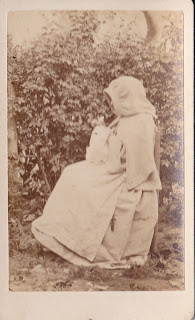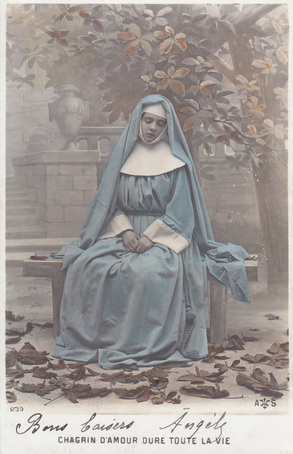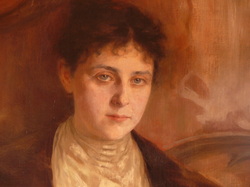
Recently I came across this unusual carte-de-visite, showing a Bernardine nun at a French convent at Anglot, a small village between the rival cities of Bayonne and Biarritz. The convent was founded in the 1830s, some twenty years before Napoleon III drew attention to Biarritz by building the Empress Eugenie a summer residence there. It became a popular resort for holidays, and my grandparents had their honeymoon there back in the 1920s.
An aristocratic Australian, Lady Fairlie Cunninghame, wrote about the Bernardines at Anglot in the 1890s, noting: “Photography is another of their industries, and very good photographs of the sisters and the convent, done by themselves, can be bought here, as well as dolls, dressed in the habit of the order, and many other prettily made ornaments and bits of work.” [Brisbane Courier 21 June 1892.]
It is therefore possible that this photograph may have been taken by one of the nuns around this time. When I wrote my thesis on 19th century clergy-photographers – including monks and friars – I was always on the look-out for female religious, but never came across much evidence for this in the UK. Over in France, thanks to the massive devotional interest in the canonised Carmelite nun Saint Thérèse of Lisieux (1873-97), I know that her sister Céline took a camera into the convent when she became a nun in 1894, although as their mother was the prioress, it is possible that this was an unusual exception! Over the next few years Céline (Sister Genevieve of Saint Teresa) took numerous photographs both of her pious younger sister and of scenes of Carmelite life, although it is clear now that many of these were considerably retouched and/or doctored. (Sophia Deboick has written a very interesting thesis on this: Image, authenticity and the cult of Saint Thérèse of Lisieux, 1897-1959 (University of Liverpool, 2011).
The commercial use of photographic images by the nuns of Anglot raises some similar questions – to what extent were these images authentic snapshots of convent life, posed photographs intended to convey the picture of religious life that they wished to promote, or staged tableaux designed for commercial appeal? Who posed for the photographs, and was it a matter of personal choice or religious obedience? Presumably the photographs were developed inside the convent – one of the interesting things I wrote about in my thesis were the range of odd times and places in which monks managed to carry out their darkroom activities. I wonder how many of these photographs from the nuns of Anglot are still in circulation?


